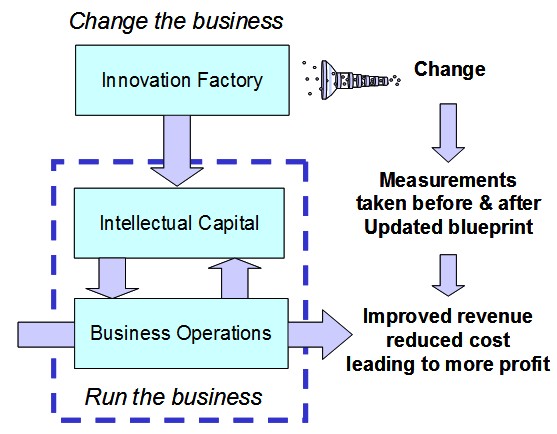Try the product development litmus test now
In this article, I’m going to show you the four biggest hurdles that consistently cause product development overruns. Then I’ll introduce you to our capability assessment system that turns your product development into a predictable strategy tool that crushes your competitors.
As the economy returns to growth, many organisations are now wrestling with innovation so as not to get left behind. For some of these companies, their product development capability was broken by cutbacks during the recession.
Others are looking to consolidate their success with a strong development capability for future growth.
So where does development and innovation fit into your business?
Well, there are two types of activity in any well-run business.
“Running the Business”
First, there are the slick operational processes for running the business which are conducted on a daily basis. They entail:
- Getting Leads
- Turning Leads into Sales
- Product Fulfilment
- Customer Support
And hopefully, these processes have been finely honed to yield a consistent and growing profit. You’ve been around the loop many times and every step is predictable and well optimised.
“Changing the Business”
Then you’ve got the other type of activity that’s relatively infrequent, that fundamentally changes the business for the better. Such as introducing new products, finding new markets, or innovating any other aspect of your operations process which all come under the heading of development.

Somehow, we expect these improvement tasks to be just as predictable as the operational tasks that have been done over and over again. In fact, ask yourself, if a new product development was that predictable and had been done many times before, then how innovative is that development?
Development Projects overrun for a myriad of reasons, but I’ve distilled all of these reasons into just 4 damaging factors:
1. Uncertainty when planning a task – not knowing for sure what customers want, whether technology will work, the best way for solving a particular problem, understanding the economics, understanding your company strategy, or even the capability of your staff. Uncertainty is just the norm when planning innovation, get used to it and learn how to create robust plans despite the uncertainty.
2. Queuing for resources – that’s queues for people, particular expertise, queues for test facilities, test results or just waiting for parts. Don’t manage your projects to achieve high utilisation of people, you will just increase the queues. Instead, optimise to increase end-to-end product life profits. Surplus staff that reduces time to market could well be a better way to go.
3. Market changes over the course of the project – this could be changing requirements, a new competitor has changed the game or new legislation has been introduced. Again get used to it, market change is just a fact of life. Where risks are high, go for small batch sizes to minimise uncertainty, preferring incremental improvement, and short development cycles. This is the essence of lean or agile development.
4. Lack of resources – perhaps just not realising the scale of the challenge, the need for the right type of expertise, or getting things wrong and having to redo it all. Through training, create expert but flexible staff who can chop and change to fill the demands.
Now worse still, any of these issues can have a catastrophic knock-on effect, where failing projects torpedo other projects in the pipeline as they rob resources. Pretty soon you’re failing on every front.
Nevertheless, some organisations do seem to have a repeatable, predictable innovation launch formula and are just killing it in the market. It’s your key weapon for dominating markets and maximising profit.
Now you’re not going to have a world-class development capability overnight, you’ll die trying. Instead, there’s an incremental journey that you can take right away.
 I’m Raglan Tribe and I’ve been managing Research and Development teams for the last 30 years. To make things easy, I’ve pulled together a simple “5-minute” assessment that helps you pinpoint where you are in terms of your development capability maturity and what the next steps should be.
I’m Raglan Tribe and I’ve been managing Research and Development teams for the last 30 years. To make things easy, I’ve pulled together a simple “5-minute” assessment that helps you pinpoint where you are in terms of your development capability maturity and what the next steps should be.
